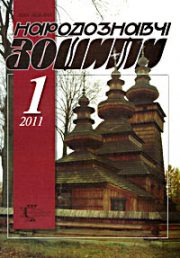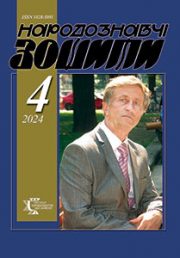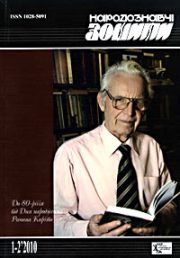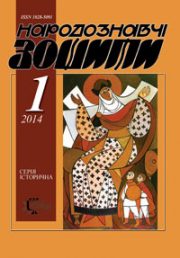The Ethnology Notebooks, 2018, № 5 (143), 1268—1278
UDK 7. 046; 7.041.6
DOI https://doi.org/10.15407/nz2018.05.1268
Received 13.06.2018
ORCID ID: https://orcid.org/0000-0002-1202-1488
Kosiv Roksolana Romanivna, Ph.D. in Art Studies, Associate Professor
of the Department of Sacral Art of the Lviv National Academy of Arts,
Senior Researcher of the Department of Old-Ukrainian Art
of the National Museum in Lviv named after Andrey Sheptytsky.
Kubiiovycha Street 38, 79011, Lviv, Ukraine.
Contacts: e-mail: lanakosiv@yahoo.com
Abstrakt. The iconography of saint monks of the Early Church from Asia Minor Onufrii, Sumeon Stovpnyk and Savva Osviashchenyi in works of Rybotychi masters in 1670—1750 years. It is indicated that their images were spread under the influence of the monastery’s environments located not far from Ribotychi, in particular the four Onufrii’s in Lavriv, Posad Rybotytskyi, Bircha and Dobromyl and the ancient monastery of St. Symeon Stovpnyk, which was located on the site of the present settlement of Patslav, which the territory of Poland near the Ukrainian border. If the image of St. Onufrii is generally known in the Ukrainian church art, the images of St. Savva and St. Symeon are rare. The works of the craftsmen of the Ribotychi are illustrative monuments about their iconography.
Keywords: iconography, icon, holy monks, St. Onuphrii, St. Savva Osviashchenyi, St. Symeon Stovpnyk, town Rybotychi.
REFERENCES
Voiakovs’kyj, N. (1998). The paths of our pilgrims. Sermons about the miraculous icons of the Mother of God. L’viv: Misioner [in Ukrainian].
Zabashta, R. (2015). The life genre in the iconography of St. Onufriy the Great: local specificity and general trends of historical development. Researchers of the Fine Arts, 4, 26—51 [in Ukrainian].
Zabashta, R. (1999). The wallpainting of the narthex of St. George church in Drohobych and the cult of the monk Onufrii in Ukraine. Lavra. Notebook of the monks of the Studite’s statute, VІ, 43—54. Univ: Sviatouspens’ka Univs’ka Lavra [in Ukrainian].
Kosiv, R. (2014). Late 1680—1690s icons painted on canvas from the Our Lord’s Transfiguration church in Vorobliachyn, Yavoriv district, Lviv region. The Ethnology notebooks, 6, 1281—1289 [in Ukrainian].
Kosiv, R. (2017). Works of art by Ivan Krulytskyy, iconpainter from the town of Rybotychi (near Przemysl, Poland) in the context of the activity of the local iconpainting center (1700’s). Bulletin of Kharkiv State Academy of Design and Arts, 5, 87—93 [in Ukrainian].
Myts’ko, I. (1999). About the beginning of St. Onufrii monastery in Lavriv. Lavra. Notebook of the monks of the Studite’s statute, VІ, 27—35. Univ: Sviatouspens’ka Univs’ka Lavra [in Ukrainian].
Sydor, O. (1999). St. Onufrii the Great and old Ukrainian art. Lavra. Notebook of the monks of the Studite’s statute, VІ, 36—42. Univ: Sviatouspens’ka Univs’ka Lavra [in Ukrainian].
Syroyid, D. (2013). Dymytrii Tuptalo and Petro Skarga through the prism of the life of St Saba the Blessed One. Ukrainian Literary Studies, 77, 307—314 [in Ukrainian].
Shematyzm of the entire Greek-Catholic clergy of the united Peremyshl’, Sanok and Sambir dioceses on the 1907 year from the Nativity of Christ. (1906). Zhovkva [in Ukrainian].
Véghseő, T., Terdik, S., Simon, K., Majchrics, T., Földvári, K., & Lágler, É. (2015). Resources for the History of Greek Catholic Parishes in Hungary: Mihály Olsavszky Mánuel Munkács Bishop 1750—1752 documents of his church visits (Vol. 7). Nyíregyháza: Szent Atanáz Görög Katolikus Hittudományi Főiskola [in Hungarian and Latin].
Gronek, A. (2015). Abandoned heritage. About paintings in the St. Onufrii church in Posada Rybotycka. Krakow: Academic bookstore [in Polish].
Franciszek, Piekosiński. (Ed.). (1887). Monumenta medii aevi historica. The Malopolska diplomatic code. (Vol. III. 1333—1386). Krakow [in Polish and Latin].
Puskás, B. (2008). The art of the Greek Catholic Church in historical Hungary: tradition and renewal. Budapest: Magyar Képek [in Hungarian].
Rozycka-Bryzek, A. (2000). Byzantine-Rus’ frescoes by the Jagiello foundation in the Lublin castle chapel. Lublin: The Lublin Museum in Lublin [in Polish].







